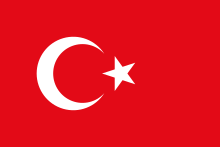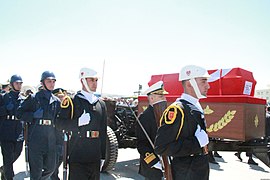Flag of Turkey
 | |
| Use | National flag and ensign |
|---|---|
| Proportion | |
| Adopted | 1844 (Ottoman flag) 1936 (current flag) |
| Design | A red field with a white star and crescent slightly left of center.[1] |
The flag of the Republic of Turkey, often referred to as the Turkish flag (Turkish: Türk bayrağı) is a red flag featuring a white star and crescent. The flag is often called al bayrak (the red flag), and is referred to as al sancak (the red banner) in the Turkish national anthem. The current design of the Turkish flag is directly derived from the late Ottoman flag, which had been adopted in the late 18th century and acquired its final form in 1844. The measures, geometric proportions, and exact tone of red of the flag of Turkey were legally standardised with the Turkish Flag Law on 29 May 1936.[2]
Contents
1 History
1.1 Legendary origins
2 Legal basis
3 Construction
3.1 Colours
3.2 Dimensions
4 Display and use
4.1 State institutions
4.2 Uniforms
4.3 Days of display
4.4 Funerals
5 Gallery
6 Notes and references
7 External links
History

The star and crescent flag of the Ottoman Empire, a late 18th-century design officially adopted in 1844
The star and crescent design appears on Ottoman flags beginning in the late 18th or early 19th century. The introduction of the white star and crescent on red as the flag of the Ottoman Empire dates to the Tanzimat reforms of 1844.
After the foundation of the Republic of Turkey in 1923, the new state maintained the last flag of the Ottoman Empire. Proportional standardisations were introduced in the Turkish Flag Law of 1936.
Legendary origins
In accounting for the crescent and star symbol, the Ottomans sometimes referred to a legendary dream of the eponymous founder of the Ottoman house, Osman I, in which he is reported to have seen a moon rising from the breast of a qadi whose daughter he sought to marry. "When full, it descended into his own breast. Then from his loins there sprang a tree, which as it grew came to cover the whole world with the shadow of its green and beautiful branches." Beneath it Osman saw the world spread out before him, surmounted by the crescent.[3]
Legal basis
Fundamentals of the Turkish flag were laid down by Turkish Flag Law No. 2994 on 29 May 1936 during the Republic period of Turkey. Turkish Flag Regulation No. 2/7175 dated 28 July 1937, and Supplementary Regulation No. 11604/2 dated 29 July 1939, were enacted to describe how the flag law would be implemented. The Turkish Flag Law No. 2893 dated 22 September 1983, and Published in the Official Gazette on 24 September 1983, was promulgated six months after its publication. According to Article 9 of Law No. 2893, a statute including the fundamentals of the implementation was also published.
Construction
Colours
In an RGB colour space, the red colour of the Turkish flag is composed of 89% red, 3.9% green, and 9% blue (in hexadecimal colour code #E30A17). In a CMYK colour space, it is composed of 0% cyan, 95.6% magenta, 89.9% yellow and 11% black. It has a hue angle of 356.4 degrees, a saturation of 91.6%, and a lightness of 46.5%. The red colour on the Turkish flag is vivid red and this colour can be obtained by blending #FF142E with #C70000. The closest websafe colour is: #d11919.
The colors approximation is listed below:
Colours scheme | Red | White |
|---|---|---|
| RGB | 227-10-23 | 255-255-255 |
| Hexadecimal | #E30A17FF | #FFFFFF |
| CMYK | 0, 96, 90, 11 | 0, 0, 0, 0 |
Dimensions
The specification below, given by Turkish Flag Law, implies that the distance between (the left edge of) the inner circle of the crescent and a vertical line connecting the two pointed ends of the crescent is 279⁄800 G = 0.34875 G; thus, the left point of the star intrudes about 0.0154 G beyond that line.

Construction sheet
| Letter | Measure | Length |
|---|---|---|
| G | Width | |
| A | Distance between the centre of the outer crescent and the seam of the white band | 1⁄2 G |
| B | Diameter of the circle around the star | 1⁄4 G |
| C | Distance between the centres of the inner and outer circles of the crescent | 1⁄16 G |
| D | Diameter of the inner circle of the crescent | 2⁄5 G |
| E | Distance between the inner circle of the crescent and the circle around the star | 1⁄3 G |
| F | Diameter of the outer circle of the crescent | 1⁄2 G |
| L | Length | 1 1⁄2 G |
| M | Width of the white hem at the hoist | 1⁄30 G |
Display and use

The Turkish Flag in vertical format

The National Cockade of Turkey
State institutions
The flag is always displayed prominently in state institutions from schools to ministries. The Çankaya Mansion, Parliament, ministries, schools, military, councils, governors buildings, muhtars offices, bridges, airports, and every state owned building in the country features one or more Turkish flags.
Uniforms
On military uniforms the flag is displayed on a patch either on the right shoulder or on the front of the uniform. Helmets can display the flag too on the front or the sides. Flight suits, navy uniforms, Jandarma uniforms and others feature the flag on shoulder patches or helmets. Along with uniforms several emblems and patches display the flag with prominence or minor alteration.
Days of display
Turkey celebrates many national events such as battle victories and Republic Day. People come to the streets with their flags to celebrate such days. On other occasions the public uses the flag heavily when protesting or commemorating certain events or deaths respectively. Statues and monuments may be draped with the flag while marches and songs are played. On television screens the flag is displayed in celebration of such events too with the portrait of Atatürk next to it. The flag may also be presented at half staff in mourning of tragic events or important days.
Funerals
The flag has a prominent display on state and military funerals. A burial flag is always draped over the deceased coffin and is carried by the military police or relatives of the deceased. Soldiers of all types and the Presidential Guard also carry the coffin at times. Many attendees also feature the flag on their lapels along with an image of the deceased.
Gallery

The Turkish flag on the Bosphorus

The flag is prominently displayed in classrooms and any and all state institutions.

The Turkish flag brought upon the annexation of Hatay.

Celebration of Republic Day

Funeral of President Evren

Turkish flag by the Bosphorus Bridge

The Turkish Embassy in Somalia

Turkish flags at half staff.
Notes and references
^ "Yurtdışı Yükseköğretim Diplomaları Denklik Yönetmeliği". Mevzuat.meb.gov.tr. Retrieved 12 December 2017.
^ "Türk Bayrağı Kanunu" [Law on Turkish Flag] (PDF). Tbmm.gov.tr. Retrieved 12 December 2017.
^ Lord Kinross, The Ottoman Centuries: The Rise and Fall of the Turkish Empire, Morrow Quill Paperbacks, 1977, pp 23-24, ISBN 978-0688080938
External links
| Wikimedia Commons has media related to Flags of Turkey. |
Türk Bayrağı Kanunu, the Turkish text of the Turkish Flag Law No. 2893 dated September 22, 1983, establishing the proportions, production, and rules of usage of the flag of Turkey
Turkey at Flags of the World

 Clash Royale CLAN TAG#URR8PPP
Clash Royale CLAN TAG#URR8PPP








